小调和弦进行是无数年来触动人心、引人入胜的歌曲的支柱。
作为一名音乐制作人,我深知理解这些进行的重要性,以创作出令人难忘、动人的音乐。
在这个全面的指南中,我们将深入探讨小调和弦的迷人世界,它们的影响,以及它们如何提升你的音乐制作。
下面是我们将要涵盖的内容概述:
小调和弦进行带来的情感冲击 ✓
不同类型的小调 ✓
基础小调和弦及其在进展中的作用 ✓- 罗马数字 ✓
创作吸引人的小调和弦进展的技巧与技巧 ✓
现代音乐中流行的小调和弦进展 ✓
将大调和和弦融入你的小调进行中 ✓
准备探索小调进行的世界。
让我们开始吧…
目录 [hide]
什么是小和弦?
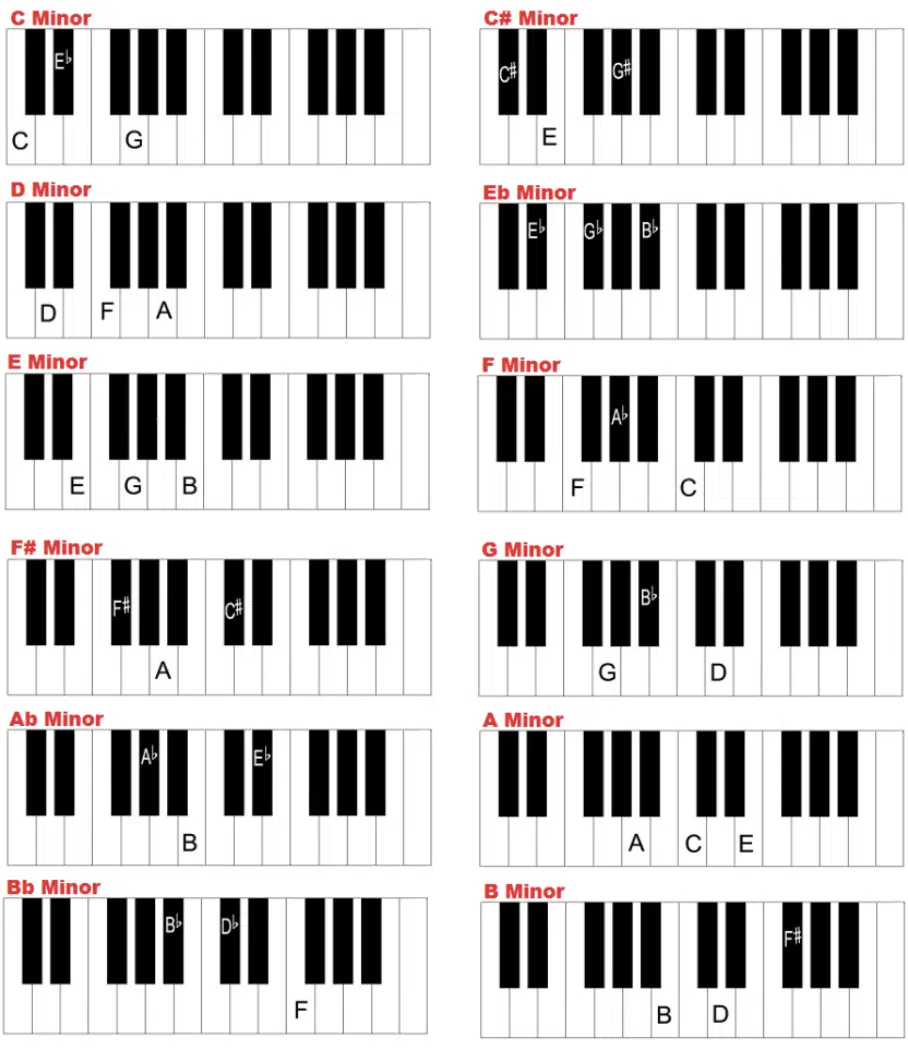
小调和弦进行有一种独特的激发深刻情感的能力,通常与悲伤、忧郁或神秘相关联。
这是由于小调和弦中音符之间的音程创造了紧张感和解决感。
当使用得当的时候,小调和弦进行可以给你的音乐增添一层深度和情感,让听众觉得着迷。
小调和弦的情感冲击力也可能因你选择的具体小调和弦进行而有所不同。
有些小调进行可以听起来更忧郁和内省,而另一些则可能具有更振奋或充满希望的品质。
通过尝试不同的 minor 调和弦进行,你可以找到完美的和弦组合,以唤起你想要在音乐中传达的特定情感。
必须理解的是,小调和弦进行所产生的情感力量并不仅限于悲伤或忧郁的音乐。
你也可以使用小调进行来创造紧张感、兴奋感,甚至是在你的音乐中营造一种神秘感。
关键在于理解不同小调和弦进行背后的情感特质,并在你的创作中有意识地运用它们。
大三和弦与小三和弦的区别
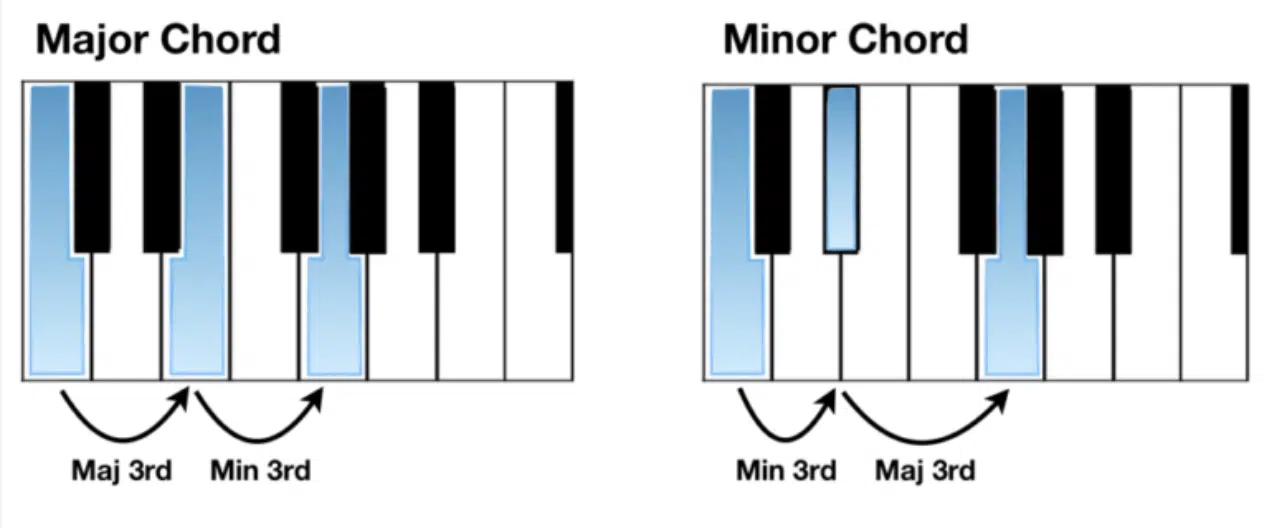
大三和弦与小三和弦的区别在于和弦的第三音。
在大三和弦中 一 第三音是根音上方的大三度音程。
在减和弦中 一 第三音是根音上方的小三度音程。
这个看似微小的音程差异对和弦的整体音色和情感质量有显著影响。
大和弦通常具有更欢快、快乐和明亮的音色,而小和弦则具有更黑暗、更悲伤和更具内省的特性。
小调和弦与大小和弦之间的这种对比是西方音乐的基本基础之一。
作为一名音乐制作人,理解和能够有效地运用这两种类型的和弦非常重要。
为了进一步理解这个概念,让我们来看看 C 大调和 C 小调。
C 大和弦由 C、E 和 G 组成,而 C 小和弦包含 C、E♭和 G。
这两和弦之间的唯一区别是 C 小调和弦中的 E♭,它赋予了和弦独特地更暗淡和更悲伤的特质。
音阶:理解构建基础
-
自然小调音阶

自然小调是三种主要的小调类型之一,也是音乐家通常首先学习的小调类型。
这个音阶源自大调音阶,具有独特的音色,可以描述为黑暗、忧郁或忧郁。
要构建一个自然小调音阶,你可以从一个大调音阶开始,并将第三、第六和第七个音符降低半音。
例如,要创建一个 A 自然小调音阶,你需要从 A 大调音阶(A,B,C#,D,E,F#,G#)开始,并将第三音(C#)、第六音(F#)和第七音(G#)降低半音。
理解自然小调对于创作和弦进行至关重要,因为它为构建小调和弦提供了基础。
此外,它还能帮助你理解在小型调中,和弦之间是如何相互关联的。
-
和声小调音阶
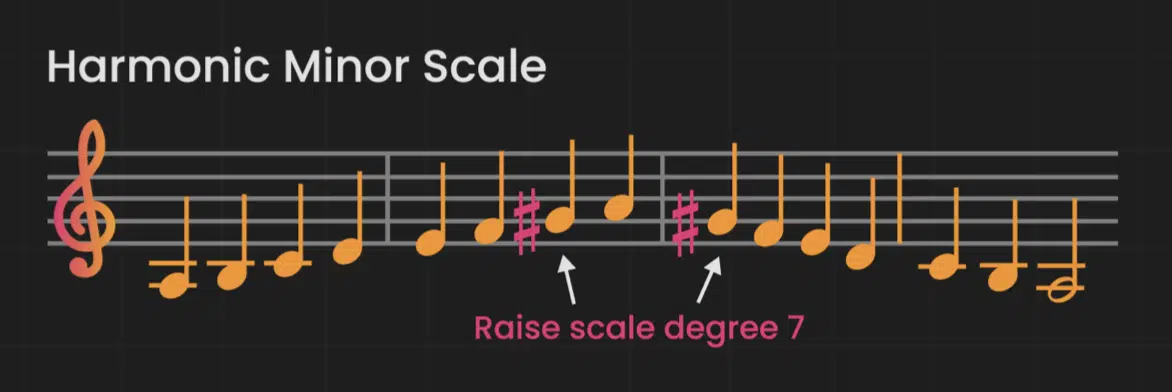
这种小调是音乐和悲伤歌曲中常用的另一种重要的小调。
这个音阶与自然小调相似,但有一个升高的七度音,这为音阶内创造了更强的紧张感和解决感。
要构建这种小调音阶,你可以从一个自然小调音阶开始,并将第七个音符升高半音。
例如,要创建一个 A 和声小调音阶,你需要从 A 自然小调音阶(A,B,C,D,E,F,G)开始,并将第七个音符(G)升高半音。
和声小调对于创作具有强烈张力和解决感的小调进行曲特别有用。
也用于创作更具有异国情调的旋律和和声。
-
旋律小调

旋律小调是三种主要的小调类型中的第三种,其特点是其独特的升调和降调形式。
上行时,旋律小调的特点是第六和第七音升高,而下行形式则恢复为自然小调。
要构建一个旋律小调音阶,你可以从一个自然小调音阶开始,在升调时将第六和第七个音符提高半音——在降调时使用自然小调音阶。
例如,要创建一个 A 旋律小调音阶,你需要从 A 自然小调音阶(A,B,C,D,E,F,G)开始,并在上行时将第六个音符(F)和第七个音符(G)升高半音。
这导致 A 旋律小调上行(A,B,C,D,E,F#,G#),而 A 自然小调下行(A,B,C,D,E,F,G)。
美声小调经常用于爵士乐和古典音乐中,以创造有趣且多样的旋律和和声。
了解美声小调可以帮助你创作出更具细腻和动态特性的小调进行。
基础小调和弦
熟悉最核心的小调和弦是创造深刻动人的进行的关键。
-
I 和弦

i 和弦是 minor 调式中的第一个和弦,作为该调式的中心音。
由以下部分组成:
- 根音
- 小三度
- 完全五度
例如,在 A 小调中,i 和弦就是 A、C 和 E(A 小调)。
这个和弦在小型进行中提供了强烈的解决感和稳定性。
说到进行,如果你想了解如何创建像 Pop Smoke 那样的和弦进行,我们制作了一个完整视频来介绍。
-
Iv Chord

iv 和弦是小调中的第四个和弦,也是一个小和弦。
它由以下组成:
- 第四级音阶
在那个音阶上方的小三度
根音上方的大五度
在 A 小调中,IV 和弦会是 D、F 和 A(D 小调)。
这个和弦通常作为 i 和弦和 v 和弦之间的过渡,提供一种运动感和期待感。
-
V 和弦

V 和弦是 minor key 中的第五个和弦,通常是一个 minor 和弦。
它由以下内容组成:
- 第五级音阶
在那个音阶上方的小三度
根音上方的大五度
在 A 小调中,v 和弦会是 E、G 和 B(E 小调)。
V 和弦制造了紧张感,当它回到 i 和弦时,这种紧张感得以解决,使其成为许多小调歌曲中的关键元素。
说到歌曲,如果你想从头开始创作一首杀手级歌曲,那就来看看我们关于如何写歌的文章。
-
vi chord

vi 和弦是 minor 调的第六个和弦,通常是一个 major 和弦。
它由以下内容构成:
- 第六级音阶
在该音上方大三度
根音上方的大五度
在 A 小调中,vi 和弦是 F、A 和 C(F 大调)。
vi 和弦可以在小调和弦进行中提供对比和缓解感,增加一丝惊喜和神秘感。
理解罗马数字
罗马数字用于表示一个调内的和弦,使其更易于理解和创建和弦进行。
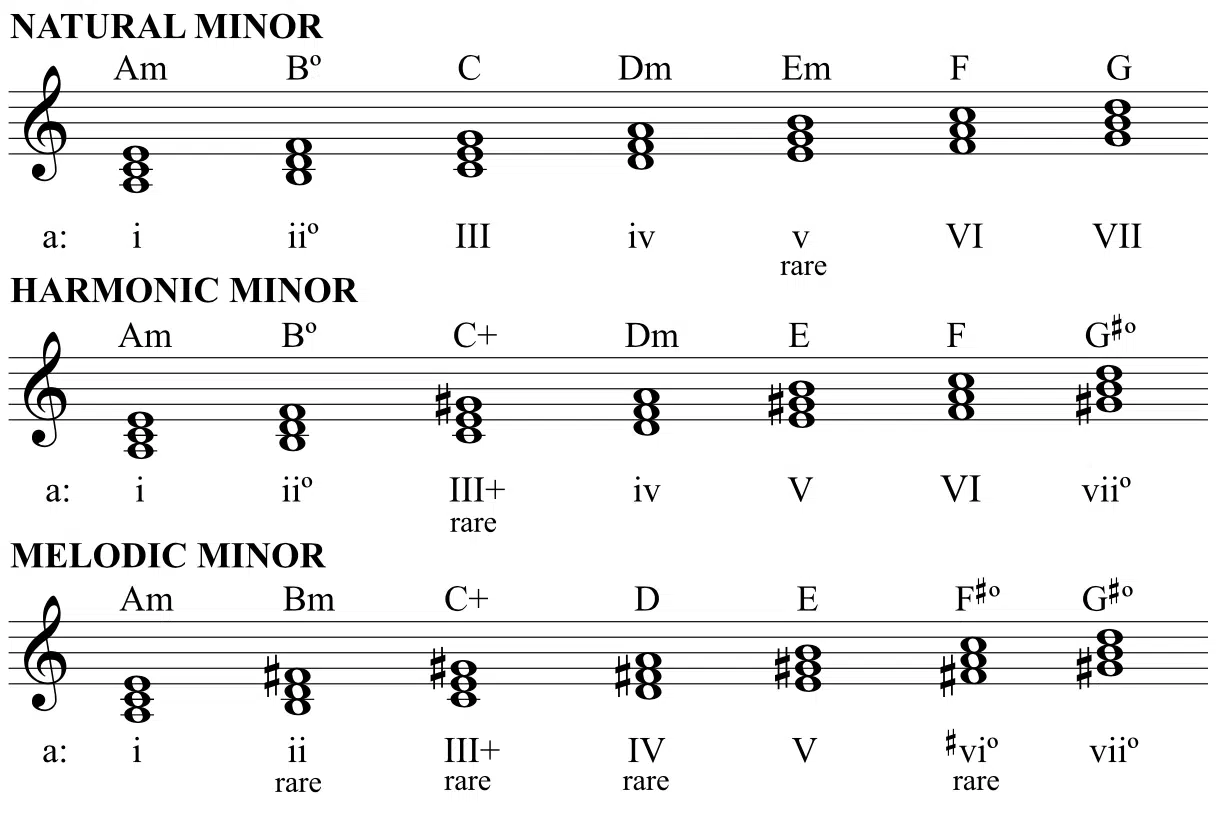
在这个系统中,每个和弦都用一个罗马数字来表示,该数字对应其在调式音阶中的位置。
在小调中,罗马数字如下:i、ii°、III、iv、v、VI 和 VII。
小写罗马数字Ⅰ表示小调和弦。
大写罗马数字 I 代表主和弦。
度数符号(°)旁边的 ii 和弦表示它是一个减和弦。
通过理解罗马数字记号法,你可以快速识别小调中的和弦,并通过组合不同的罗马数字来创建和弦进行。
像 Kendrick Lamar 和 Marshmello 这样的大牌艺术家经常用这种方法来创作嘻哈和弦进行。
用罗马数字创造小调进行
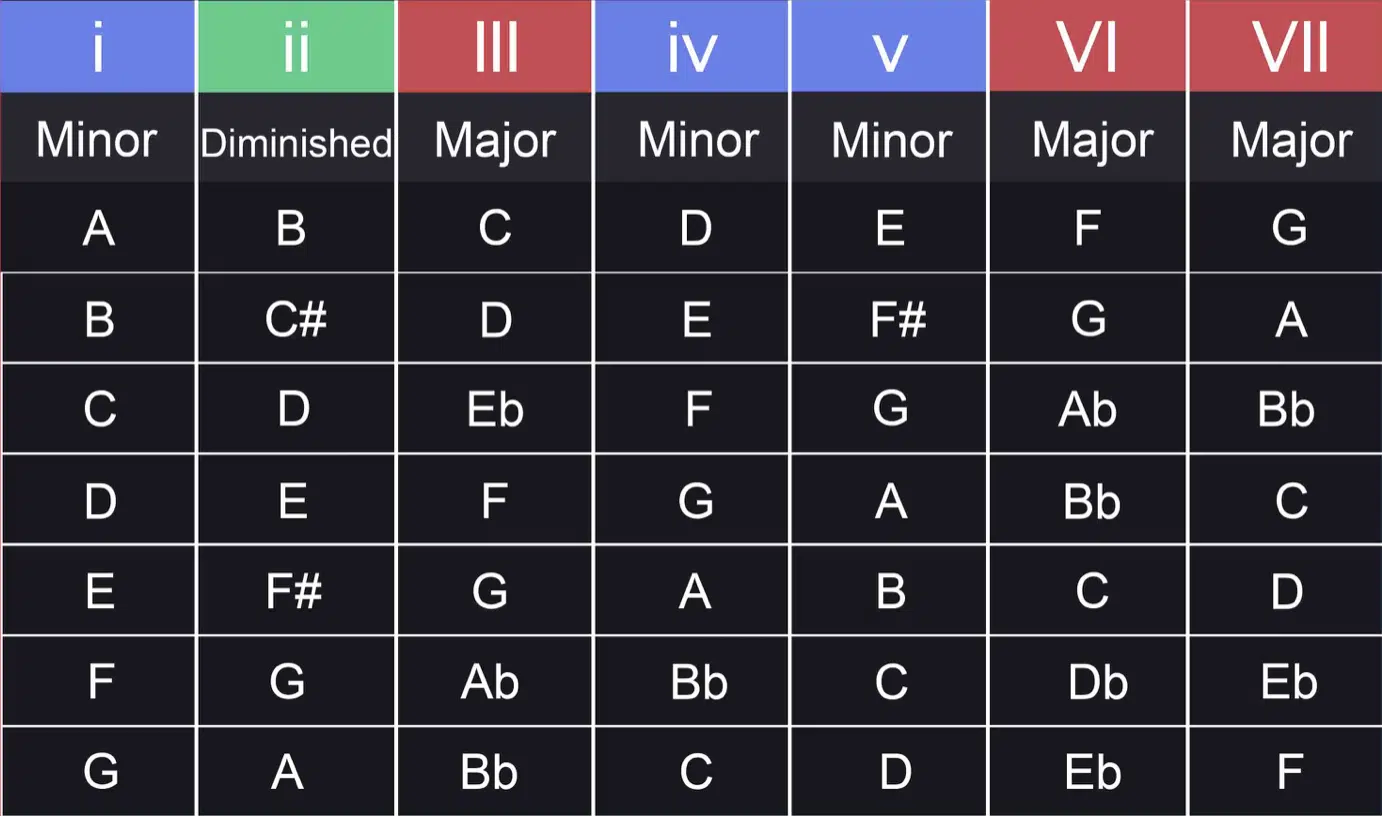
一旦你掌握了罗马数字记号法,你就可以通过组合不同的罗马数字来开始创建小调进行。
例如,一个常见的 minor 调和弦进行是 i-iv-v 进行,正如前面提到的,它使用了小调中的第一 (i)、第四 (iv) 和第五 (v) 个和弦。
使用罗马数字可以让你轻松地将你的和弦进行移调到不同的小调。
如果你有一个 A 小调的和弦进行,并想将其移调到 E 小调,你可以简单地使用相同的罗马数字,并将它们应用到 E 小调上。
这种灵活性和移调的便利性使得罗马数字记号法成为创建引人入胜的小调进行的一个非常有价值的工具,可以轻松地适应不同的音乐情境。
常用小调和弦进行
在众多不同流派的歌曲中,包括嘻哈子流派,都存在一些常见的 minor 调和弦进行。
这些流行的和弦进行通常作为创作小调中引人入胜和充满情感的音乐的基础。
I-Iv-V 进行曲

i-iv-v 进行是一个经典的 minor 和弦进行,常出现在蓝调和摇滚音乐中。
它唤起一种渴望和内省的感觉。
在 A 小调中,这个进行会由和弦 Am(i)、Dm(iv)和 Em(v)组成。
一个现代的 i-iv-v 进行例子可以在 Nine Inch Nails 的歌曲“Hurt”中找到,这首歌被 Johnny Cash 著名翻唱。
这首歌的副歌部分采用了这个进行,营造出一种忧郁和感伤的氛围。
I-VI-III-VII 进行

你经常会遇到一个常见的 minor 和弦进行,即 i-VI-III-VII 进行。
这个进行可以唤起一种神秘和悲伤的感觉,因此它是许多作曲家常用的选择。
在 A 小调中,这个进行会由和弦 Am(i)、F(VI)、C(III)和 G(VII)组成。
Imagine Dragons 乐队的“Radioactive”就是一个 i-VI-III-VII 进展的流行例子。
这首歌的副歌和主歌部分都使用了这个进展,为其带来了强烈而有力的声音。
I-Iv-V-I 进行曲
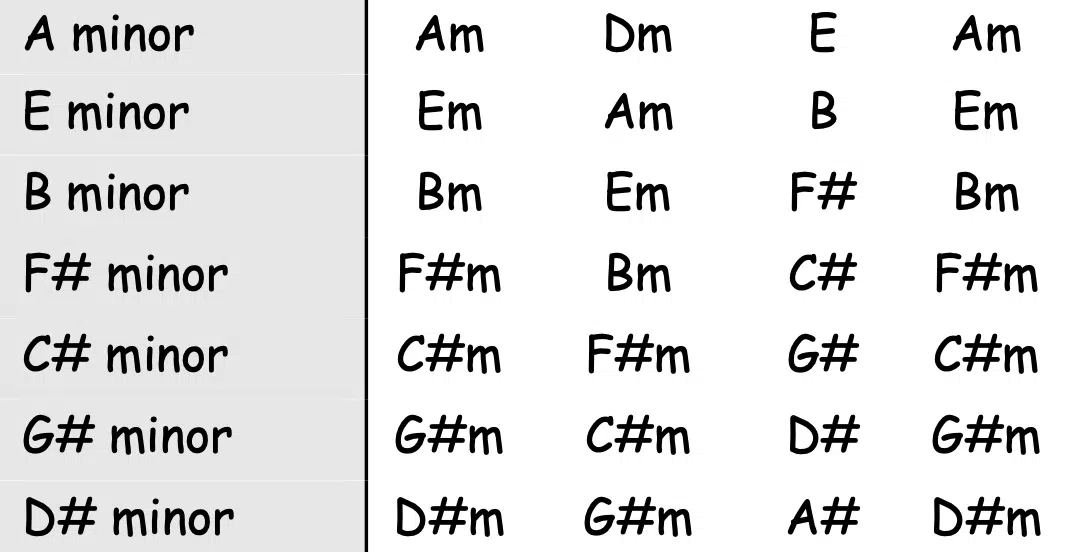
The i-iv-V-i progression is another popular chord progression that adds a resolution back to the tonic (i) chord after the v chord.
This progression is often used in pop and rock music for its emotional impact.
In the key of A minor, this progression would consist of the chords Am (i), Dm (iv), E (V), and Am (i) again.
A well-known song that uses the i-iv-V-i progression is “Bad Guy” by Billie Eilish.
The verse sections of the song feature a variation of this progression, giving the track a distinctive and eerie vibe.
The iv-i-V progression

The iv-i-V progression is another common minor chord progression that is particularly effective in creating a sense of anticipation and release.
In the key of A minor, this progression would consist of the chords Dm (iv), Am (i), and E (V).
An example of the iv-i-V progression can be found in the song “Take Me to Church” by Hozier.
The verse sections of this song use this progression, adding to the song’s dramatic, soulful, impactful tone.
Building Your Own Minor Chords

To create minor chords, you need to understand the concept of intervals, specifically the minor third and perfect fifth intervals.
A minor chord consists of:
- A root note
- A minor third interval above the root
- A perfect fifth interval above the root
The minor third interval is what gives the chord its characteristic “sad” or “dark” sound.
To build a minor chord, start with the root note and count up three semitones (half steps) to find the minor third.
Then, count up seven semitones (half steps) from the root to find the perfect fifth.
These three notes together form a minor chord.
Let’s take a look at building a C minor chord as an example.
- Start with the root note: C
- The minor third interval above C is: E♭
- The perfect fifth interval above C is: G
Therefore, a C minor consists of the notes C, E♭, and G.
Building minor chords can be done for any note in a minor scale, allowing you to create a series of chords that can be used to form minor progressions.
Once you’ve mastered the basic structure of minor chords, you can create chords with different voicings and inversions to add variety and depth to your chord progressions.

Voicings refer to the arrangement of notes within a chord, while inversions involve changing the order of the notes, with a note other than the root in the bass.
For example, on a keyboard, you could try playing the A minor chord with the C note as the lowest pitch, creating the first inversion (C-E-A).
Speaking of pitch and bass, if you’re looking for the best pitch shifter plugins or the first AI bass generator ever, look no further.
5 Examples of Popular Songs with Minor Chord Progressions
Understanding music theory can open up a world of possibilities for any music producer, especially when it comes to analyzing popular songs.
If you need a refresher course, or just want to excel in your knowledge of Music Theory, we got your back.
To give you an idea of how these chord progressions have been used in recent hit songs, let’s take a look at 5 popular examples:
-
“Shape of You” by Ed Sheeran
Ed Sheeran’s chart-topping hit “Shape of You” features a catchy i-III-iv-iv progression in the key of C♯ minor.
The combination of the infectious melody and rhythm, along with the minor chord progression, helped make this song a massive success and a staple in modern pop music.
-
“Bad Guy” by Billie Eilish
“Bad Guy” features a distinctive i-iv-v-i progression that gives the song its eerie and menacing vibe.
This progression helps create an unforgettable sound that has captured the attention of listeners worldwide.
-
“Blinding Lights” by The Weeknd
In “Blinding Lights,” The Weeknd uses an i-VI-III-VII progression in the key of E♭ minor.
The driving synth lines and catchy melody work together with this minor chord progression, creating an 80s-inspired sound that has resonated with a wide audience.
-
“Without Me” by Halsey
Halsey’s hit song “Without Me” is based on an i-VI-III-VII progression in the key of D♭ minor.
The moody and introspective nature of the progression complements the deeply personal lyrics, showcasing the versatility of minor chord progressions in contemporary pop music.
These examples demonstrate how a solid understanding of music theory and minor progressions can help you create powerful and memorable beats that resonate with listeners.
-
“Royals” by Lorde
Lorde’s breakthrough hit “Royals” employs an i-v-III-III progression in the key of D minor.
This song’s minimalist production and the use of minor chords create a moody atmosphere that complements the lyrics, which critique materialism and wealth.
The distinctive sound and relatable message have made “Royals” an enduring favorite among listeners.
Tips & Techniques for Building Minor Chord Progressions
Now that you’re familiar with the basics, here are some tips & techniques for building your very own minor chord progressions.
-
Experimenting with Chord Inversions

Chord inversions are a technique that involves changing the order of the notes in a chord, which can add interest and variety to your basic chord progression.
By using inversions, you can create smoother transitions between chords and achieve different voicings that give your music a unique sound.
To create an inversion, you can move the lowest note of a chord up an octave or the highest note down an octave.
For example, the root position of an A minor chord is A, C, and E.
- The first inversion 一 Would be C, E, and A (with the C now as the lowest note).
- The second inversion 一 Would be E, A, and C (with the E as the lowest note).
Experimenting with different chord inversions can help you discover new harmonic possibilities.
Plus, create minor chord progressions that sound fresh, engaging, and far from basic.
-
Borrowing Chords from Parallel Major and Minor Keys
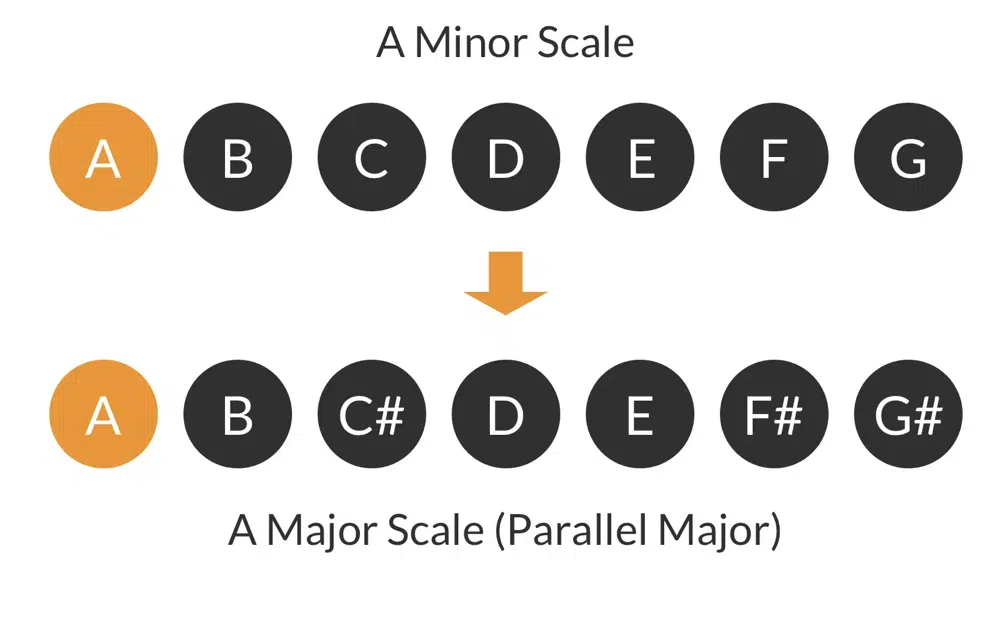
Chord borrowing is a technique that involves using chords from a parallel major or minor key in your minor chord progressions.
This can add unexpected harmonic twists and create a more complex, rich sound.
For instance, if you’re working in the key of A minor, the parallel major key is A major.
You could borrow chords from the A major key, such as the A major chord itself, and incorporate it into your minor chord progression to create a sense of mystery and intrigue.
Don’t be afraid to play around with borrowing chords from parallel minor and major keys.
This can open up new possibilities for your minor chord progressions and help you create music that is more dynamic and engaging.
-
Combining Different Types of Minor Scales
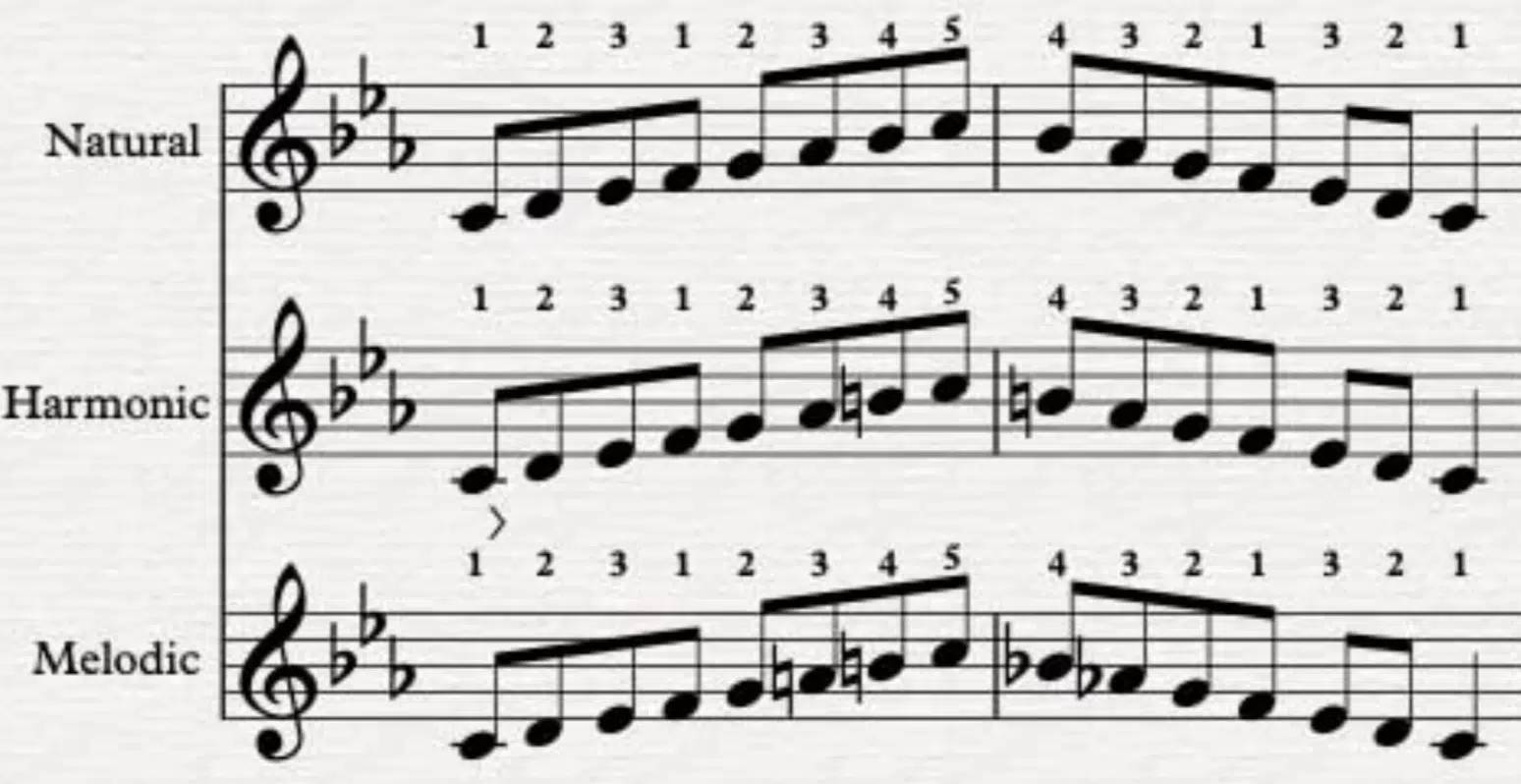
Another technique for crafting unique minor chord progressions is to combine chords from different types of minor scales, such as the natural, harmonic, and melodic minor scales.
This can create interesting harmonic textures and add depth to your music.
You might create a chord progression in A minor using chords from the A natural minor scale, then introduce a chord from the A harmonic scale (minor) for added tension and drama.
Experimenting with chords from different minor scales can help you uncover new harmonic ideas.
Plus, it gives your minor progressions a more nuanced, intriguing sound.
Side note, if you’re unsure of the minor scales and major scales, we break them down and explain all the different moving parts.
Major Chords Within Minor Progressions
Major chords can be found in minor keys, usually as the III, VI, or VII chords.
These chords can add interest and variety to a minor chord progression, creating moments of brightness and tension.
In the key of A minor, the III chord would be C major, the VI chord would be F major, and the VII chord would be G major.
-
Major iv chord
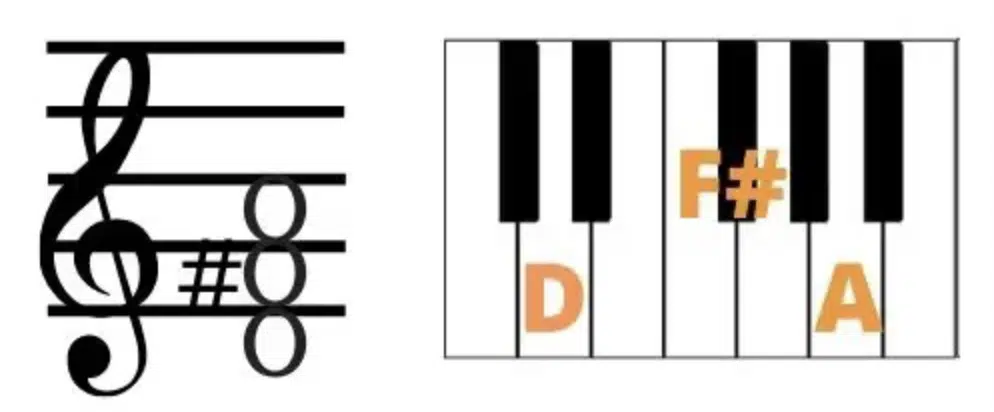
Occasionally, a major iv chord can be used within a minor chord progression to add a sense of tension and surprise.
This involves raising the minor third of the iv chord to a major third.
In the key of A minor, the major iv chord would be D, F#, and A (D major).
This chord can create an unexpected twist in your minor chord progression, which can help blow your audience away and make them feel your music on a whole different level.
-
Major Chord Progressions

Major chord progressions can also be used within a minor key, often as borrowed chords from the parallel major key.
This uses Music Theory to create a sense of contrast and add harmonic richness to your music.
In the key of A minor, for example, you could borrow chords from the parallel key of A major, such as the I, IV, and V chords (A major, D major, and E major).
Exploring vi-iii-vii Progressions

The vi-iii-vii progression is a captivating and emotional chord progression that can be found in many songs across various genres.
It typically involves the sixth (vi), third (iii), and seventh (vii) chords in a minor key.
This progression has a strong sense of movement and drama, often evoking feelings of longing, sadness, and introspection.
It can be an effective choice when you want to create a deeply emotional and powerful musical moment.
There are numerous examples of the vi-iii-vii progression in popular music, showcasing its versatility and emotional impact.
Some of these examples include Radiohead’s “Exit Music (For a Film),” The Beatles’ “While My Guitar Gently Weeps,” and Adele’s “Hello.”
By studying these songs and others that feature the vi-iii-vii progression, you can gain a better understanding of how to use it effectively in your own music and create compelling minor chord progressions.
E Minor: A Powerful and Popular Key

E Minor is a popular key for many musicians, known for its dark, powerful, and emotive qualities.
The key consists of the notes E, F#, G, A, B, C, and D, with the E minor chord (E, G, B) serving as the tonal center.
The key of E Minor can evoke a range of emotions, from melancholy and introspection to intensity and passion, making it a versatile choice for all vibes and styles.
Examples of songs in E Minor

There are countless songs written in the key of E Minor, showcasing its emotional depth and appeal.
Some notable examples of E minor key chord progressions include Nirvana’s “Come As You Are,” Led Zeppelin’s “Stairway to Heaven,” and Billie Eilish’s “Bury a Friend.”
By studying these songs and others in E Minor, you can gain a better understanding of the key’s unique qualities and learn how to harness its power in your own minor chord progressions.
Mixing Major & Minor Keys
Major and minor keys are related through their relative and parallel relationships.
The relative minor key shares the same key signature as its major counterpart, while the parallel minor key has the same root note but a different key signature.
Understanding the relationship between major and minor keys can open up new possibilities for blending these two tonalities in your chord progressions.
This will help you produce music that is more diverse and emotionally jam-packed.
Since we keep mentioning the word “parallel,” I would be remiss not to mention our extensive article all about parallel processing.
How To Incorporate Major Keys Into Your Minor Chord Progression
One way to incorporate major keys into minor chord progressions is by borrowing chords from the parallel major key, which can create moments of brightness and surprise within the progression.
Another approach is to use the relative major key as a point of contrast, transitioning between the minor and major tonalities.
This will evoke a range of emotions and create a more enjoyable (and addictive) listening experience.
Bonus: Understanding Leading Tones

A leading tone is the seventh scale degree of a major or harmonic minor scale 一 which is a half step below the tonic (root) note.
Leading tones create a sense of tension that is resolved when they move to the tonic note.
In a minor key, the leading tone is particularly important for creating tension and drama within chord progressions, often used in conjunction with the V or vii° chords.
Leading tones play a crucial role in establishing tension and resolution within minor chord progressions.
They can help to create a sense of momentum and anticipation, leading the listener to expect a resolution back to the tonic (i) chord.
By incorporating leading tones into your minor chord progressions, you can add depth and intensity to your music, creating a more engaging and dramatic final product.
Minor Chord Progressions: Final Thoughts
As we reach the end of our journey through minor chord progressions, you’re now equipped with the knowledge and techniques to create your very own mind-blowing masterpieces.
Playing around with different progressions, blending major and minor keys, and harnessing the emotional power of minor chords will help you craft unforgettable (and addicting) tracks.
To further elevate your music production skills, you’ve got to check out these beautifully crafted free Advanced MIDI Chord Progressions.
They will empower you to produce captivating and alluring progressions that resonate with your listeners and leave a lasting impression.
Plus, when you use them, you’ll set yourself apart from 99% of producers who just have access to basic chords & progressions!
Remember, experimentation is key, not only when it comes to chord progressions, but in production as a whole, so go crazy 一 there are no limits.
Until next time…







Leave a Reply